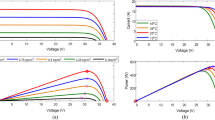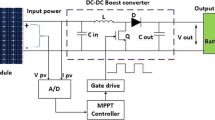Abstract
Due to its abundant natural supply and environmentally friendly features, solar photovoltaic (PV) production based on renewable energy is the ideal substitute for conventional energy sources. The efficiency of solar power generation under partial shading conditions (PSCs) is significantly increased by maximizing power extraction from the PV system. The maximum power point tracking (MPPT) method is to track maximum PowerPoint (MPP). This research proposes a photovoltaic MPPT control in partial shading conditions using Loxo-Canis (LOXOCAN) optimization algorithm. The ultimate goal of the novel method is to track the solar photovoltaic system’s maximum power point under conditions of partial shading using the LOXOCAN algorithm. The proposed LOXOCAN algorithm is a combination of Elephant-herd optimization (EHO) and Coyote Optimization Algorithm (COA). The \(K_{p} ,K_{i} ,\) and \(K_{d}\) parameters of the PID controller of the MPPT controller will be tuned to their optimum values using the proposed optimization strategy. Higher MPPT performance and a quick convergence at the global maxima are shown in the proposed Loxo-Canis approach. Also, the recommended hybrid Loxo-Canis MPPT approach offers faster MPPT, less computational work, and higher efficiency.











Similar content being viewed by others
Data availability
Data sharing is not applicable to this article as no new data were created or analyzed in this study.
Abbreviations
- ChOA:
-
Chimp optimization algorithm
- COA:
-
Coyote optimization
- CS:
-
Cuckoo search
- CSO:
-
Cat swarm optimization
- EGWO:
-
Enhanced grey wolf optimization
- EHO:
-
Elephant-herd optimization
- GMPP:
-
Global maximum power point
- GMPPT:
-
Global power point tracking
- GOA:
-
Grasshopper optimization algorithm
- GWO:
-
Grey wolf optimization
- HC:
-
Hill climbing
- ICSA:
-
Improved cuckoo search algorithm
- INC:
-
Incremental conductance
- LOXOCAN:
-
Loxo-Canis
- MGWO:
-
Modified grey wolf optimization
- MHA:
-
Meta-heuristic algorithms
- MLFO:
-
Modified Levy flight optimization
- MPPT:
-
Maximum power point tracking
- OGWO:
-
Original GWO
- P&O:
-
Perturb and observe method
- P&O:
-
Perturb and observe
- PS:
-
Partial shading
- PSC:
-
Partial shading condition
- PSCs:
-
Partial shadowing conditions
- PSO:
-
Particle swarm optimization
- PV:
-
Photovoltaic
- P–V:
-
Power–voltage
- RES:
-
Renewable energy sources
- SPV:
-
Solar photovoltaic
References
Hsieh, G.-C., Hsieh, H.-I., Tsai, C.-Y., & Wang, C.-H. (2012). Photovoltaic power-increment-aided incremental-conductance MPPT with two-phased tracking. IEEE Transactions on Power Electronics, 28(6), 2895–2911.
Millah, I. S., Chang, P. C., Teshome, D. F., Subroto, R. K., Lian, K. L., & Lin, J.-F. (2022). An enhanced grey wolf optimization algorithm for photovoltaic maximum power point tracking control under partial shading conditions. IEEE Open Journal of the Industrial Electronics Society, 3, 392–408.
Femia, N., Petrone, G., Spagnuolo, G., & Vitelli, M. (2005). Optimization of perturb and observe maximum power point tracking method. IEEE Transactions on Power Electronics, 20(4), 963–973.
Patel, H., & Agarwal, V. (2008). MATLAB-based modeling to study the effects of partial shading on PV array characteristics. IEEE Transactions on Energy Conversion, 23(1), 302–310.
Ahmed, J., & Salam, Z. (2015). An improved method to predict the position of maximum power point during partial shading for PV arrays. IEEE Transactions on Industrial Informatics, 11(6), 1378–1387.
Chiu, H.-J., Lo, Y.-K., Lee, T.-P., Chen, Q. S., Yu, W. L., Lee, J.-X., Shih, F., & Mou, S.-C. (2011). A battery charger with maximum power point tracking function for low-power photovoltaic system applications. International Journal of Circuit Theory and Applications, 39(3), 241–2565.
González-Castaño, C., Restrepo, C., Kouro, S., & Rodriguez, J. (2021). MPPT algorithm based on artificial bee colony for PV system. IEEE Access, 9, 43121–43133.
Bauwens, P., & Doutreloigne, J. (2014). Reducing partial shading power loss with an integrated smart bypass. Solar Energy, 103, 134–142.
Nagadurga, T., Narasimham, P. V. R. L., Vakula, V. S., Devarapalli, R., & Márquez, F. P. G. (2021). Enhancing global maximum power point of solar photovoltaic strings under partial shading conditions using chimp optimization algorithm. Energies, 14(14), 4086.
Nagadurga, T., Narasimham, P. V. R. L., & Vakula, V. S. (2021). Global maximum power point tracking of solar photovoltaic strings under partial shading conditions using cat swarm optimization technique. Sustainability, 13(19), 11106.
Charin, C., Ishak, D., Mohd Zainuri, M. A., & Ismail, B. (2021). Modified levy flight optimization for a maximum power point tracking algorithm under partial shading. Applied Sciences, 11(3), 992.
Subramanian, A., & Raman, J. (2021). Grasshopper optimization algorithm tuned maximum power point tracking for solar photovoltaic systems. Journal of Ambient Intelligence and Humanized Computing, 12(9), 8637–8645.
Verma, P., Alam, A., Sarwar, A., Tariq, M., Vahedi, H., Gupta, D., Ahmad, S., & Shah Noor Mohamed, A. (2021). Meta-heuristic optimization techniques used for maximum power point tracking in solar PV system. Electronics, 10(19), 2419.
Motamarri, R., Bhookya, N., & ChittiBabu, B. (2021). Modified grey wolf optimization for global maximum power point tracking under partial shading conditions in photovoltaic system. International Journal of Circuit Theory and Applications, 49(7), 1884–1901.
Eltamaly, A. M. (2021). An improved cuckoo search algorithm for maximum power point tracking of photovoltaic systems under partial shading conditions. Energies, 14(4), 953.
Kumar, V., Ghosh, S., Swami Naidu, N. K., Kamal, S., Saket, R. K., & Nagar, S. K. (2021). Load voltage-based MPPT technique for standalone PV systems using adaptive step. International Journal of Electrical Power & Energy Systems, 128, 106732.
Toumi, D., Benattous, D., Ibrahim, A., Abdul-Ghaffar, H. I., Obukhov, S., Aboelsaud, R., Labbi, Y., & Diab, A. A. Z. (2021). Optimal design and analysis of DC–DC converter with maximum power controller for stand-alone PV system. Energy Reports, 7, 4951–4960.
Nayak, B., Mohapatra, A., & Mohanty, K. B. (2017). Selection criteria of DC–DC converter and control variable for MPPT of PV system utilized in heating and cooking applications. Cogent Engineering, 4(1), 1363357.
Osmani, K., Haddad, A., Lemenand, T., Castanier, B., & Ramadan, M. (2021). An investigation on maximum power extraction algorithms from PV systems with corresponding DC–DC converters. Energy, 224, 120092.
Ramki, T., & Tripathy L. N. (2015). Comparison of different DC–DC converter for MPPT application of photovoltaic system. In International Conference on Electrical, Electronics, Signals, Communication and Optimization (EESCO) (pp. 1–6).
Peng, L., Sun, Y., & Meng, Z. (2014). An improved model and parameters extraction for photovoltaic cells using only three state points at standard test condition. Journal of power Sources, 248, 621–631.
Ishaque, K., Salam, Z., & Taheri, H. (2011). Modeling and simulation of photovoltaic (PV) system during partial shading based on a two-diode model. Simulation Modelling Practice and Theory, 19(7), 1613–1626.
Balasubramanian, I. R., Ilango Ganesan, S., & Chilakapati, N. (2014). Impact of partial shading on the output power of PV systems under partial shading conditions. IET power Electronics, 7(3), 657–666.
Pathak, D., Sagar, G., & Gaur, P. (2020). An application of intelligent non-linear discrete-PID controller for MPPT of PV system. Procedia Computer Science, 167, 1574–1583.
Li, J., Lei, H., Alavi, A. H., & Wang, G.-G. (2020). Elephant herding optimization: Variants, hybrids, and applications. Mathematics, 8(9), 1415.
Tuba, E., & Stanimirovic, Z. (2017). Elephant herding optimization algorithm for support vector machine parameters tuning. In 2017 9th International Conference on Electronics, Computers and Artificial Intelligence (ECAI) (pp. 1–4). IEEE.
Ismaeel, A. A. K., Elshaarawy, I. A., Houssein, E. H., Ismail, F. H., & Hassanien, A. E. (2019). Enhanced elephant herding optimization for global optimization. IEEE Access, 7, 34738–34752.
Güvenç, U., & Kaymaz, E. (2019). Economic dispatch integrated wind power using coyote optimization algorithm. 2019 7th international Istanbul smart grids and cities congress and fair (ICSG) (pp. 179–183). IEEE.
Pierezan, J., & Coelho, L. D. S. (2018). Coyote optimization algorithm: a new metaheuristic for global optimization problems. 2018 IEEE congress on evolutionary computation (CEC) (pp. 1–8). IEEE.
Abdelwanis, M. I., Abaza, A., El-Sehiemy, R. A., Ibrahim, M. N., & Rezk, H. (2020). Parameter estimation of electric power transformers using coyote optimization algorithm with experimental verification. IEEE Access, 8, 50036–50044.
Funding
This research did not receive any specific funding.
Author information
Authors and Affiliations
Contributions
AMB conceived the presented idea and designed the analysis. Also, he carried out the experiment and wrote the manuscript with support from RLJ. All authors discussed the results and contributed to the final manuscript. All authors read and approved the final manuscript.
Corresponding author
Ethics declarations
Conflict of interest
The authors declare no conflict of interest.
Ethical approval
The conducted research is not related to either human or animal use.
Informed consent
Not Applicable.
Additional information
Publisher's Note
Springer Nature remains neutral with regard to jurisdictional claims in published maps and institutional affiliations.
Rights and permissions
Springer Nature or its licensor (e.g. a society or other partner) holds exclusive rights to this article under a publishing agreement with the author(s) or other rightsholder(s); author self-archiving of the accepted manuscript version of this article is solely governed by the terms of such publishing agreement and applicable law.
About this article
Cite this article
Aron, M.B., Louis, J.R. A novel intelligent optimization-based maximum power point tracking control of photovoltaic system under partial shading conditions. Analog Integr Circ Sig Process 118, 489–503 (2024). https://doi.org/10.1007/s10470-023-02216-1
Received:
Revised:
Accepted:
Published:
Issue Date:
DOI: https://doi.org/10.1007/s10470-023-02216-1




